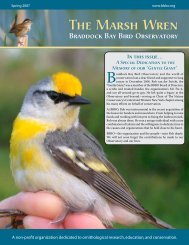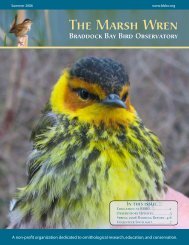Spring 2010 - Braddock Bay Bird Observatory
Spring 2010 - Braddock Bay Bird Observatory
Spring 2010 - Braddock Bay Bird Observatory
You also want an ePaper? Increase the reach of your titles
YUMPU automatically turns print PDFs into web optimized ePapers that Google loves.
arrowwood (Viburnum dentatum). Cages were built<br />
around each planting in an effort to deter the deer.<br />
Pussy willow (Salix discolor) will be planted in the<br />
wettest areas this spring.<br />
Boardwalks were also built along some of the<br />
muddier trails in order to provide better access to<br />
the net lanes. This effort is important for the safety<br />
of our banders, as well as the safety of the birds being<br />
carried back to our processing station. Additional<br />
boardwalk construction is planned for this summer,<br />
some directly related to the banding effort and others<br />
to provide access to areas for use by students and<br />
faculty in other environmental science courses.<br />
Research Published<br />
Betsy Brooks’ remarkable efforts in studying breeding<br />
bird communities in Allegany County over the past<br />
35-years are being featured in the June <strong>2010</strong> issue<br />
of the Wilson Journal of Ornithology, a scientific<br />
journal published by the Wilson Ornithological<br />
Society. Beginning in the late 1960s, Betsy tirelessly<br />
documented the breeding birds at three study sites<br />
near her home in Alfred, New York. Much has<br />
changed in the landscape surrouding Betsy’s study<br />
area in the past few decades, and her study provides<br />
a very rare long-term view on changes in breeding<br />
bird communities. The article will be available at the<br />
banding station this spring. Congratulations, Betsy!<br />
E. W. Brooks and D. N. Bonter. <strong>2010</strong>. Longterm<br />
changes in avian community structure in<br />
a successional, forested, and managed plot in a<br />
reforesting landscape. Wilson Journal of Ornithology<br />
122:288-295.<br />
Former Intern Writes Book<br />
Fo r m e r B B B O f i e l d<br />
assistant Charley Eiseman<br />
has recently published a<br />
wonderful book, Tracks<br />
& Sign of Insects and<br />
Other Invertebrates. The<br />
book is a field guide to<br />
egg cases, cocoons, webs,<br />
nests, leaf mines, galls,<br />
burrows, wood borings,<br />
and other curiosities left<br />
behind by insects, spiders,<br />
snails, worms, and other<br />
critters as they go about<br />
their lives. After working<br />
at BBBO, Charley earned<br />
a Master’s degree from the<br />
University of Vermont’s<br />
Field Naturalist program in Natural Resources. You<br />
can order the book and learn more about Charley’s<br />
recent exploits at this website:<br />
www.charleyeiseman.com/book.html<br />
Conference & Workshop<br />
The Wilson Ornithological Society will hold its <strong>2010</strong><br />
conference at Hobart and William Smith Colleges<br />
in Geneva, New York from May 20-23. On May 23,<br />
a tour from the conference will visit the banding<br />
station. Following the conference, Peter Pyle, author<br />
of the Identification Guide to North American <strong>Bird</strong>s,<br />
will lead an advanced bird banding workshop at<br />
BBBO.<br />
Which species is it?<br />
Can you identify this<br />
unusual catch at BBBO<br />
(right)? The answer will<br />
appear in the next issue<br />
of The Marsh Wren.<br />
Photos: Grasshopper Sparrow by Ryan<br />
Kayhart, quiz bird by Greg Lawrence.<br />
The relatively long bill and flat head shape are key to<br />
identifying this Grasshopper Sparrow (left) from the last<br />
issue of The Marsh Wren.




